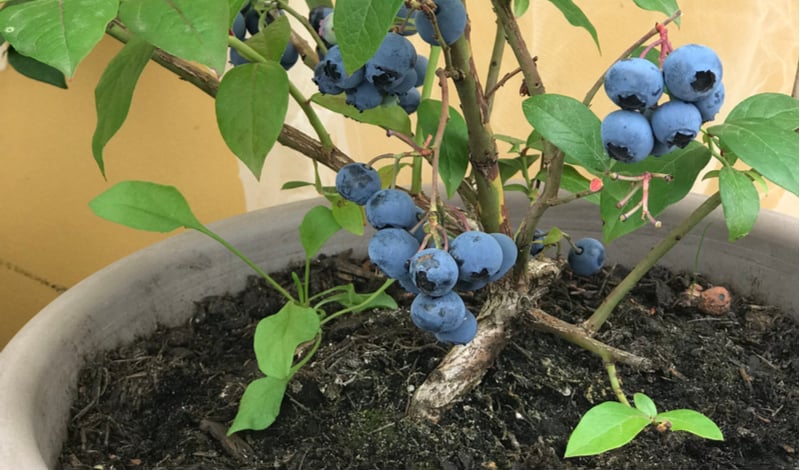Last updated on January 21st, 2020
Our site is reader supported, this means we may earn a small commission from Amazon and other affiliates when you buy through links on our site.
Blueberries are incredibly healthy for you and, relatively simple to care for. When it comes to growing blueberries in containers, the requirements are easy, get a good-sized pot, not too small but big enough to get compost around the edges. Get some John Innes ericaceous compost which is acidic and designed for lime hating plants which blueberries are and keep the soil moist but not wet, remembering that container-grown plants need watering much more often than those grown in the ground.
To learn more about planting and growing blueberry plants in pots read on.
Plant in ericaceous compost which for lime hating plants
When growing blueberries in container, because they need acidic soil they need to be planted in ericaceous compost. As they prefer moist soil we recommend going for a soil-based compost such as John Innes Ericaceous compost as this will retain moisture better.
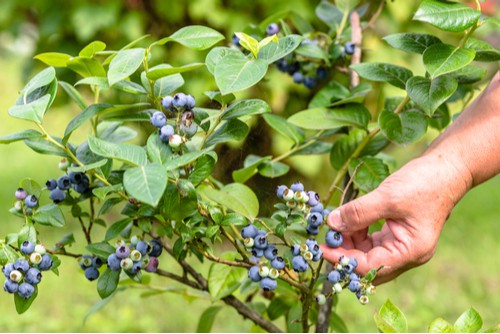
Do you need multiple plants?
With blueberries, some varieties like Bluecrop and Sunshine Blue are self-fertilizing which means you don’t need multiple bushes. You can grow a single blueberry plant in one container and it will produce fruit.
Other varieties need a second plant to cross-pollinate. Before you purchase a blueberry plant, make sure you verify whether it’s a self-fertilizing plant or whether it will need a companion. You don’t want to find out after the first year of no berries that you should have invested in two.
Choosing the Container
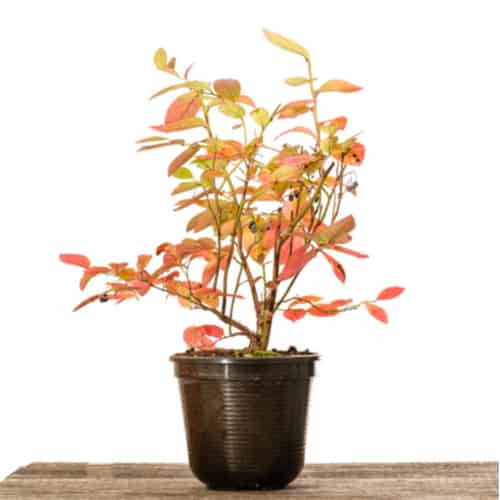
The container you choose needs to be around 50-60cm in diameter if you but one in a 2/3 litre pot if you buy a smaller plant then the pot can be smaller to match. It has to be big enough to support the full root system of the blueberry bush plus a little extra space. Blueberries have dense, fibrous root systems which means they need room not only to spread out but to receive and store ample moisture. Choosing the right size will ensure the plant gets enough water to produce fruit successfully.
Beyond size there are very few concerns you have to worry about when choosing your container. Any material will do. What’s most important is what you put in the container.
What Compost to Use
 Ericaceous compost suitable for blueberries available Amazon.co.uk
Ericaceous compost suitable for blueberries available Amazon.co.uk
As already mentioned, the compost that you use is paramount. You need lime-free, acidic growing medium for blueberries. Standard, multi-purpose potting soil will be insufficient. You will know if you picked the wrong soil because the foliage will turn yellow very quickly and your growth will be stunted but you obviously want to not make this mistake in the first place. You must use ericaceous compost, ideally soiled based so it retains moisture better to encourage more prolific flowering and subsequently fruit.
When to Plant
Container-grown plants can be planted at any time of the year, but, early spring or autumn are the best times to plant. You will probably find blueberry bushes on sale at these times of the year as well.
How to Plant a blueberry into a container
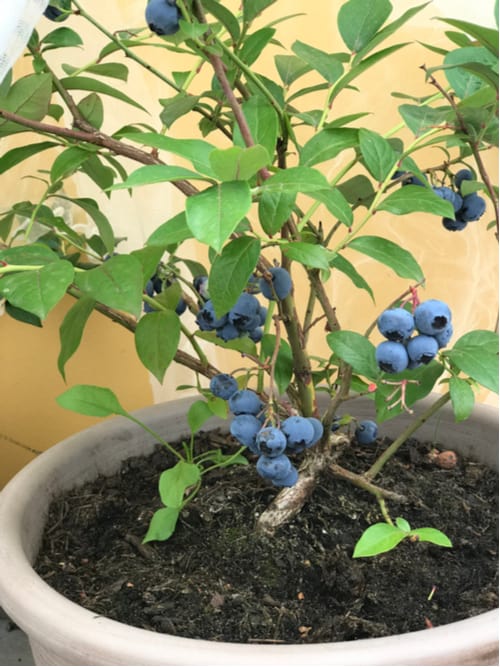
Once you are ready with your plants prepared, water the plant before you move it to its final home. While it is sitting, absorbing the water, partially fill the container with the ericaceous compost. Carefully remove the blueberry from its pot and place it in the new container. Fill in the remaining area with the remaining compost mixture, lightly tapping it in place with your fingertips until you have filled the pot to the brim, and then lightly firm it in place. You want the top of the soil to be a couple of inches below the rim of the pot so you can water easily and doesn’t run over the edge of the pot.
Watering
Always keep the compost moist but never leave it soaking. On the other end of the spectrum never let it dry out in between waterings and remember they will need watering much more often than those grown in the ground. If you can help it, water your blueberries with rainwater rather than tap water. Blueberries prefer highly acidic soil and if you use tap water it can change the pH balance which can cause your blueberries to grow poorly.
Feeding
 Bumper Crop Fertiliser for Blueberries – Available from Amazon.co.uk
Bumper Crop Fertiliser for Blueberries – Available from Amazon.co.uk
Once the blueberry bush is planted you need to water it. You will need to do this regularly because blueberries hate dry roots. You should also give it an annual mixture of feed appropriate for Rhododendrons often sold as eracous feed just like the compost, but no more than this. Blueberries are very light feeders.
Maintaining a blueberry bush in a container means that every spring you should remove the surface a compost, between 5 and 10 centimetres, and add a handful of fresh fertilizer with ericaceous compost. Some blueberries have the second phase of growth at the end of summer so you can add a small bit of fertilizer in the middle of summer to help encourage this second flush.
Pruning blueberries in pots
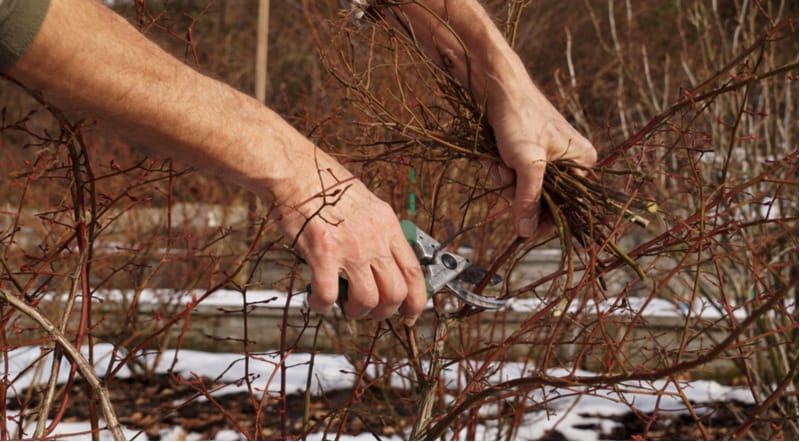
The best fruit is produced on branches that are 3 years old. But after that, the older branches decline in terms of their production. At this point, you will have to prune the old wood away to make room for new wood. Throughout the first few years, you should only prune damaged or disease would, or branches that are crossing one another and preventing air circulation. This is, of course, a method of pruning you should continue for the lifespan of your blueberry bush but, as the bush ages, integrate the renewal pruning to encourage new canes.
Read more about pruning blueberries in our comprehensive pruning guide by clicking here
Picking the Fruit
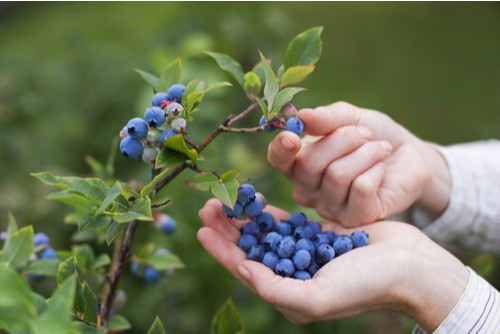
Growing blueberries in pots is a great way to have pickable, fresh berries in your garden no matter how limited your space might be. Blueberries need acidic soil but beyond that as long as you have the right fertilizer and compost they will thrive in containers. What’s more, they do well in shady areas of the garden which is perfect for people who might have covered patios that don’t get a lot of sunlight but still want to cultivate something rewarding and healthy. You can pick fruit as early as the first year, but rest assured that by the third year you will have berries as you have never grown before. Having fresh, delicious berries on hand will make it so much easier to spice up your morning granola or add the finishing touch on a delicious dessert.
Protecting berries from birds and controlling aphids
The most common problem you will face is that a bird. Birds, particularly pigeons, we’ll try to eat the buds, the leaves, the fruits, and everything in between. You can cover your blueberry bushes with netting which is easy to do with plant in pots using a few canes. Keep your eyes peeled for aphids. You will see these on the tips of the plant or the leaves. You can remove them by spraying them with water, or applying fruit friendly pesticide spray.

